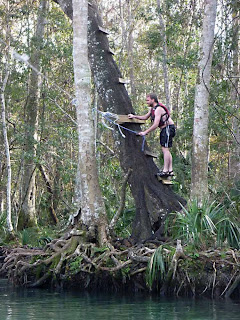Duration of Best Power
This is the second blog post on a tip to improve your forward stroke. If you missed the first, it is below this in the blog, posted on 1/19/2010.
In the prior post, we mentioned the four phases of the forward stroke, the wind up, the catch, the power phase and the exit. Our last tip can be summarized by saying get the paddle as vertical as possible (front to back), and fully immersed, before applying power, and keep it that way until you pull the paddle out.
Second part of the tip concerns the length of your stroke. Let's look at the windup, before the catch phase, and the exit of our stroke.
Where does your stroke start? Can you easily change this? Probably. By prerotating during the windup phase you can massively increase the length of the stroke and by extending your upper arm, have all of this additional length with the blade in the most powerful position. Here's a way to see how this works. Wherever you are right now, sit straight up as you would in your kayak. Keep your shoulders square, facing forward, and reach forward noting how far you can reach. Now repeat this after twisting at your waist while reaching forward. When you do this you will notice that one arm can reach further while the other reaches less. Most people can reach about 6 inches more by rotating than by starting with their shoulders square.
For most people, the length of their stroke while the blade is nearly vertical is less than 2 feet, many people much less. And, by prerotating they can add about 6 inches to this. That alone will create about 25% more pull to each stroke. Adding more power by having the blade nearly vertical, as discussed before, adds even more. And, extending the stroke by rotating more during the power phase, adds even more.
Many of us have been told our stroke is too long, or that the stroke should end somewhere around the hips. Why is that? Should yours?
Our exit phase should begin before the blade goes past vertical, from the blade's shoulder to its tip. So the guideline about "at your hips" is a general idea of the spot for most paddlers. Is that the spot for you? Can you change this? Possibly. You can get a longer power stroke with the blade still vertical by rotating further during the power phase.
To make this work, your hands have to move together. You need to move them together to keep the blade nearly vertical. If you will focus on keeping the blade as vertical as possible throughtout the stroke, you will get this right. At some point you will get to the limit of your flexibility. You just won't be able to rotate any further. That is the time to pull the paddle out.
Where is the paddle relative to your hip? For some people it is up by their thigh. They aren't very flexible. That should be the limit of their stroke. For others, their paddle may be well past their hips. They are more flexible and will have a longer stroke in the bet power position.
To review, the best power comes from a paddle blade that is nearly verticle, from the shoulder to the tip of the blade. We can extend the duration of this at the start by prerotating. We get the paddle into this nearly vertical position by extending our upper arm before applying power. We keep it in the position by moving our hands together in the same relative direction. And, we can make our stroke longer if we can retate our torso further before we pull the paddle out.
So adding anywhere from 25% to 50% more propulsion from each stroke is fairly easy to do.
Now it is time to put this into practice. Get on the water and try it out.
Oh! The water is frozen where you live? Or it is colder than you want to paddle in. Or, you only get a little time on the water? So what. Here's the last tip in this message. Set aside at least 5 minutes every day and practice air paddling. Grab your paddle. Go through the motions where ever you are. Get help from a coach if you are not sure. Then practice a little while every day. In less than 100 days - before beach weather in most of the US, you will have a radically improved stroke.
























































